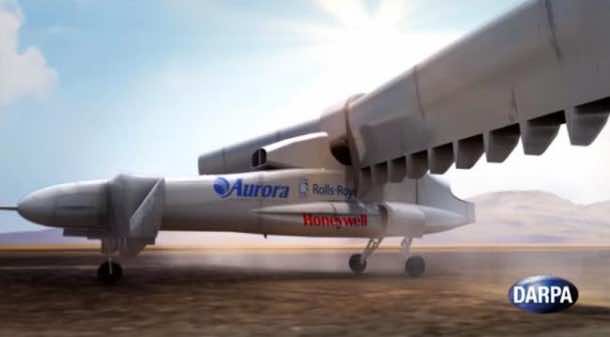DARPA’s VTOL Experimental Plane (VTOL X-Plane) features a modular and cellular wing design that resembles a set of flying cupboards. Despite its odd looks, this unmanned aircraft is a hybrid between fixed-wing and rotary wing technology that has been designed for the creation of a VTOL aircraft capable of exhibiting an increased range and speed capabilities.
Although VTOL aircraft have been worked upon for over a 100 years now but they have always lacked in one aspect or another. DARPA’s VTOL X-Plane Program is looking to improve the payload, range, stability and speed qualities by making use of a new modular design that will supposedly bring about some drastic improvements in vertical and horizontal flight capabilities.
The idea is to create an aircraft that is capable of maintaining a top speed of 300-400 knots, hovers with a minimum efficiency of 75%, the cruise lift-to-drag ratio is reduced from 5-6 to 10 and is capable of carrying a payload of 10,000-12,000 pounds.
The VTOL X-Plane comes as a result of the Aurora Flight Sciences Corporation’s Phase 2 design contract for the program. It features two big rear wings along with two small front canards. They comprise of cells that feature 24 ducted fans – nine are placed in each wing while three in each canard. Each of these 24 fans feature their own electric motor and powered via turboshaft engine off a V-22 Osprey tiltrotor aircraft that is capable of generating 4,000hp of electrical power.
In order to control this peculiar arrangement, the VTOL X-Plane features power distribution systems for multiple fans in a ‘transmission-agnostic air vehicle deign’. Now what on Earth does that mean? It means there’s no gearbox and therefore, the flight control system is able to vary the thrust of each fan independently for efficiency as well as during conversion from vertical to horizontal flight and back.
Ashish Bagai, DARPA program manager says, “This VTOL X-plane won’t be in volume production in the next few years but is important for the future capabilities it could enable. Imagine electric aircraft that are more quiet, fuel-efficient and adaptable and are capable of runway-independent operations. We want to open up whole new design and mission spaces freed from prior constraints, and enable new VTOL aircraft systems and subsystems.”
Flight tests have been slated for 2018 and DARPA claims that VTOL X-plane technology is also suited for manned aircraft.
